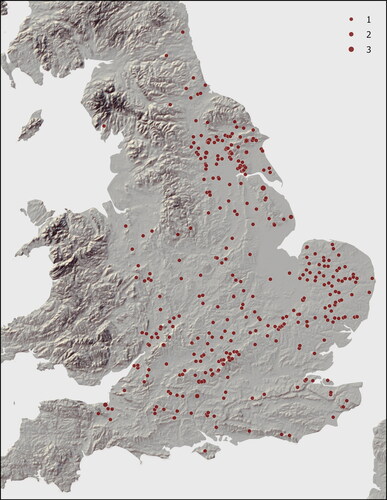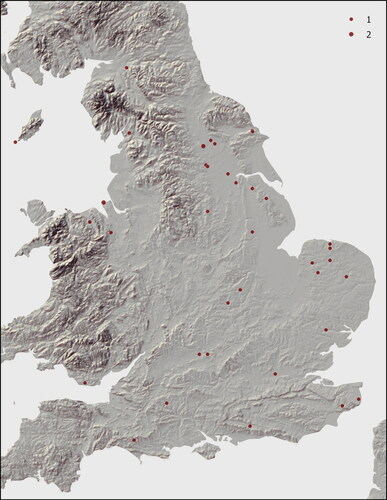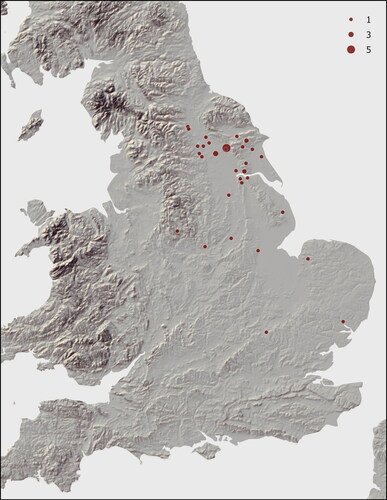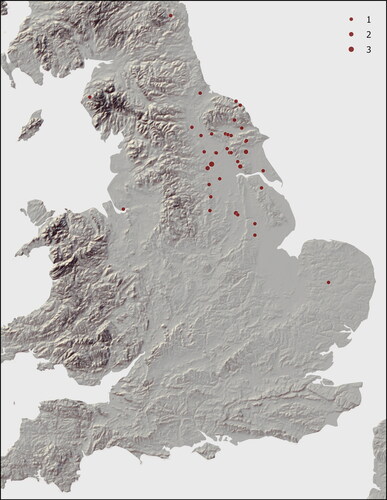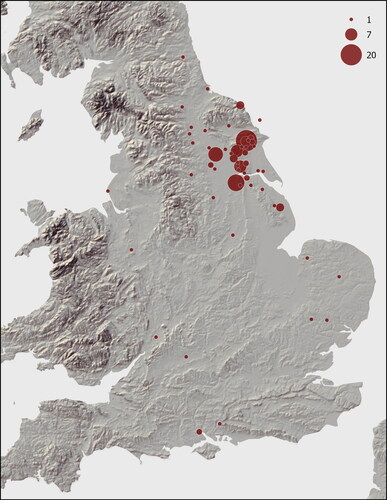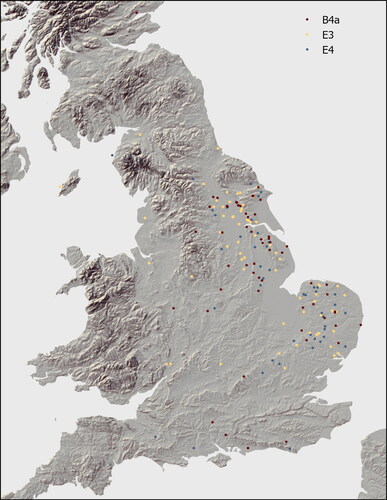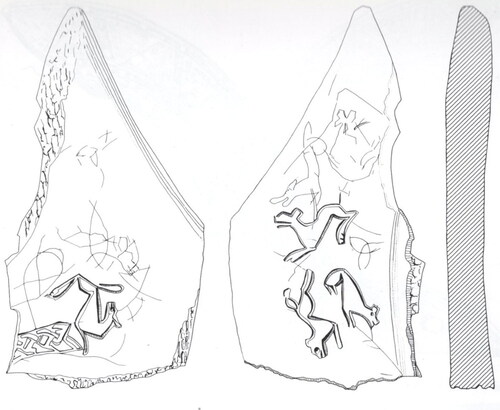Abstract
This paper discusses several categories of dress accessory which we suggest are linked to the arrival of the so-called Viking Great Army in Northumbria in the late ninth century. In particular, we argue that double-sided strap-ends and buckles arrived from Dublin as sword-belt fittings, alongside five-lobed hollow and cast sword pommels, and that this was closely followed by the introduction of new strap-end and pin types. Unlike the preceding Anglo-Saxon chip-carved strap-ends which were frequently fashioned by hand, the new Viking forms were cast, and the Northumbrian focus of their distribution reflects their production at Aldwark and York. This evidence reflects important changes in metalwork production as a result of the arrival of the Great Army, leading to long-lasting impact.
Introduction
Documentary sources provide only a cursory outline of the events that rocked Northumbria in the late ninth century, when a force described as the Viking Great Army first arrived in York on All Saints’ Day in 866 and subsequently killed the rival claimants to the kingdom, Ælla and Osberht, installing a series of puppet kings. Part of the Army returned north in 875 under its leader Healfdene to impose direct Scandinavian rule and ultimately to seize the land of the Northumbrians where they ‘proceeded to plough and to support themselves’ (Whitelock Citation1961, 48; Townend Citation2014, 25–53; Hadley and Richards Citation2021, 201–222). Archaeological evidence, particularly that derived from metal-detecting, is now establishing what lies behind the events outlined in our historical framework in considerable detail. In recent years, winter camps of the Great Army have been identified at Torksey, Lincolnshire (Hadley and Richards Citation2016) and Aldwark, North Yorkshire (Williams Citation2020), along with many other sites visited by its offshoots (Hadley and Richards Citation2018). In this paper we show how detailed analysis of artefacts recovered from such sites can help us to develop even more nuanced insights into the Army’s activities. We discuss a selection of dress accessories associated with the Great Army, examining their distribution, stylistic influences and manufacturing techniques. Low levels of data have previously prohibited such an approach, but the Portable Antiquities Scheme now permits new insights.
Artefact groups associated with the Viking Great Army
The discovery of a Viking camp at Aldwark, in North Yorkshire, some 20 kilometres northwest of York, may indicate where much of the Great Army over-wintered when it first visited York in 866–67, although most finds are probably connected to Healfdene’s return north in 875–76 (Williams Citation2020). Here a huge mass of Viking plunder has been recovered over the last 20 years, allegedly amounting to c.7,000 items. Like those from another camp at Torksey on the Trent in Lincolnshire (Hadley and Richards Citation2016), the finds reflect the disparate groups that made up the Army: alongside Scandinavian and Anglo-Saxon objects, there are artefacts from Carolingian Europe and Ireland. In the wider countryside, our work has identified over thirty new sites which we propose were visited by offshoots of the Army, some of which were abandoned while others were settled by subsequent generations of Scandinavians (Hadley and Richards Citation2016, Citation2018; Richards and Haldenby Citation2018). This research has defined an archaeological ‘signature’ for the Great Army and contributed to a more refined dating of artefacts that occur neither before the arrival of the Army nor survive in use for much more than a few decades.
Amongst the categories of artefact which we have identified as being associated with the Great Army is a group of strap-ends with distinctive interlace decoration, classified by Thomas (Citation2000a, 104) as Class B5 (see ). In this paper we offer a new analysis of these strap-ends, and consider two other artefact types which we argue are contemporaneous with them: the so-called Wooperton-type strap-ends (Bailey Citation1993; Thomas Class A1avii; see ), and plate-headed pins (Haldenby Citation2012; see ). Their national distributions together with the presence of shared features within and between the groups, underpins a new refined dating and sequence of artefact development. The B5 strap-ends have generally been considered to derive from an Anglo-Saxon milieu, albeit adopting Scandinavian-inspired decoration, leading only to a general late ninth-/early tenth-century date (Graham-Campbell Citation1980, 11; Thomas Citation2000a, 205). Here, however, we suggest a narrower date range, reflecting their distinctive Northumbrian distribution, which is far more restricted than both their Anglo-Saxon antecedents and subsequent Scandinavian forms, arguing that they were cast in Yorkshire workshops now operating under Viking control. Furthermore, the lack of variation in the decoration of the strap-ends suggests use of a limited number of models for their casting, and hence a short shelf-life. Together with their restricted distribution, this can be explained partly in terms of the particular circumstances of production and trade within Northumbria between the capture of York in 866 and the wider recorded Scandinavian settlement from 876 onwards. We suggest that the new strap-end and pin types were introduced at the same time, but that they soon went out of use, being replaced by longer-lived types during the Scandinavian settlement from the late 870s.
Artefact distributions before the arrival of the Great Army
Before commencing our analysis, we need to establish the broader context of artefact usage in the ninth century. We will use the distribution of strap-ends in use before the arrival of the Army to reveal pre-existing patterns of dress accessory usage.
Class A1 strap-ends
The distribution of all Class A1 strap-ends, dating broadly to the ninth century, provides a good control sample for a ‘normal’ pre-Viking Anglo-Saxon artefact distribution. The type is numerous, has distinctive Trewhiddle-style animal art decoration (named after the metalwork hoard found near Trewhiddle in Cornwall in 1774), and mainly predates the arrival of the Viking Great Army. In his doctoral thesis, Thomas (Citation2000a, 229–231) remarked upon their widespread popularity, albeit noting a northern bias which has since been confirmed by the recovery of many more examples (). Collared pins are even more numerous and share the same widespread distribution as these strap-ends, but without a northern bias. The ubiquity of these clothing accessories is indicative of common customs of dress, facilitated by stable, open and longstanding trading networks across Anglo-Saxon England. All of this was about to change with the arrival of the Great Army and the development of new Viking dress accessories.
Great Army introductions
Class F double-sided strap-ends
Class F double-sided strap-ends were a new introduction to late ninth-century England (). These differ markedly from the main Anglo-Saxon series (Thomas Class A), having parallel sides, a roundel towards the terminal, a stepped and expanded reverse butt-end, and unprecedented double-sided decoration which typically comprises paired panels, often of Borre-style interlace on both sides. On decorative and archaeological grounds Thomas (ibid., 216) dated these strap-ends to the late ninth into tenth century but cited Graham-Campbell’s slightly earlier, narrower dating of not much later than 900. Their use with buckles of similar size and decoration was inferred by Thomas (ibid., 281) who listed two buckles and 13 strap-ends (ibid., cat.1301–1313), to which another five buckles and 22 strap-ends can now be added from the PAS and other sources.Footnote1 Yet, despite their incorporation of Borre-style interlace they are not found in Scandinavia; rather the number of finds from Ireland and use of Insular-derived interlace provides strong evidence for seeing the origins of Class F in ninth-century Ireland, where they were probably manufactured in Dublin itself (Richardson Citation1993, 152–157; Thomas Citation2000a, 216, Citation2000b, 246). Moreover, their wider distribution within the Irish Sea area reflects their transmission by Viking incomers (). They are also found in small numbers but widely distributed across southern and eastern England, where Thomas (Citation2000a, 254, Citation2000b, 249) suggested some might represent contemporary copies made there, as these are a derivative form often lacking the central perforation through the roundel.
Figure 2. Examples of Class F strap-ends and buckle plates: LANCUM-2AD712 (left); top row, left to right: NMS-627136, YORYM-077738, LANCUM-8AE737; bottom centre: SUSS-742D82; buckle plates: Aldwark sf 925 (top), YORYM-55A828 (bottom) (Images courtesy of PAS and York Archaeological Trust).
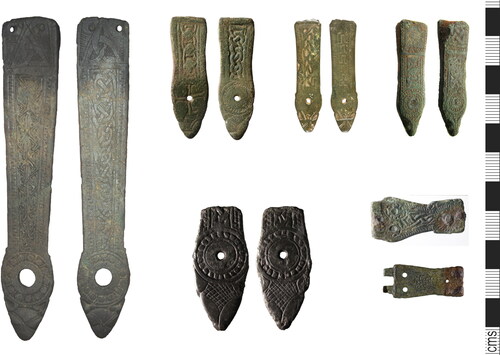
A clue to understanding the significance of these paired double-sided strap-ends and buckles may be provided by the excavation of a Class F strap-end in the Cronk Moar Viking burial on the Isle of Man. It was found along with a strap-distributor and sword scabbard fittings which, according to Wilson (Bersu and Wilson Citation1966, 63–83), served as attachments for sword belts. This suggests that rather than being seen as humble dress accessories, the Class F strap-ends should be seen as part of the sword strap fittings of a ninth-century Viking warrior. A warrior connection and Irish Viking origins combined with the dispersed but sparse distribution of Class F strap-ends across England is commensurate with the earliest examples being associated with the large-scale Viking military incursions of the mid- to late-ninth century. Additional support for a warrior connection comes from the Class F strap-end and companion buckle found at the Great Army camp at Aldwark (Williams Citation2020, 53–54).
Other sword fittings
Numerous sword fittings may well be Great Army losses, in view of their military connections. These also include over 50 homogenous undecorated five-lobed, hollow cast copper-alloy sword pommels. This particular type of pommel is highly standardised and has such a low profile in Scandinavia and on the continent that it does not appear in Petersen’s classification, although examples are sometimes described as an undecorated variant of Petersen Type L (Aksdal Citation2017, 87; Vlasaty Citation2018). It is also similar to Petersen’s five-lobed Type O pommel which, like Form L, may have been manufactured in England (Martens Citation2004). However, it is distinguished from Type O by its method of manufacture, by which the pommel was attached to the hilt by means only of peening (or bending over) the tang where it protruded through the pommel (Vlasaty Citation2018).
The surprising numbers of these undecorated cast pommels with peened tangs now recorded from across England may be best explained by such Viking weaponry having seen much movement and considerable military action, as well as by the pommels having been weakly attached to the hilt in the first place. It is also possible that they reflect the stripping of pommels for re-use. The number of individual losses far exceeds that of any other type of Viking or Anglo-Saxon sword pommel. Given this and their uniformity it is tempting to conjecture that they and the swords to which they belonged were mass produced in Ireland to equip a Hiberno-Norse element of the Great Army, in readiness for mass incursions into England.
Kevin Leahy (Citation2014, 38) already suggested Irish Vikings, and the subsequent settlement of a Hiberno-Norse faction of the Army, as an explanation for the discovery of Insular objects in North Lincolnshire, including Class F strap-ends and decorative Irish metalwork that has often been pierced or cut. The possibility of a link between such metalwork and the Great Army is strengthened by our nationwide mapping of all such finds, which are widely dispersed with significant numbers from beyond the area of later Scandinavian settlement in northern and eastern England. We conclude that various sword-related artefacts, including the variant Type L pommels, along with hacked Irish metalwork seen in large quantities at Aldwark and Torksey, are associated with Great Army activities, alongside other artefact types of probable Irish origin including ringed-pins such as the example found on the cremation pyre of a warrior in the Great Army cemetery at Heath Wood, Derbyshire (Richards et al. Citation2004, 75–76).
Dress accessories from Viking-occupied Northumbria
Having outlined the broad distributions of dress accessories in use in England before the arrival of the Great Army, and of some other object types with military associations which we suggest were introduced by the Army from Ireland, we will now explore the new types which we propose were created in Northumbria under the influence of the Army. These have a considerably more restricted distribution, with high levels of homogeneity evident in their manufacture which helps to establish a new component of the archaeological signature of the Great Army.
Class B5 strap-ends
Class B5 strap-ends are found on a number of Northumbrian sites with a Viking artefactual component (Haldenby and Richards 2018, 339). A closer examination of the group is now warranted because their shared features suggest that they were inspired by the Irish Class F group: deeply-contoured interlace decoration; parallel-sided form (in contrast to the main Anglo-Saxon Class A series which have convex sides); stepped thickening of the reverse butt-end (once again in contrast to the preceding Anglo-Saxon strap-ends); and the frequent decoration of the reverse side with a simple peripheral groove. With only nine B5 strap-ends then known, Thomas (Citation2000a, 104) was prevented from suggesting subdivisions, being only able to comment on the diversity of their decorative interlace. If one discounts the example from Meols, which appears to be a Class F strap-end, his list is reduced to eight strap-ends from across eastern England which is too few to show any clear distribution pattern. We now know of 39 examples which can be divided into three groups on the basis of their particular interlace, here described as sub-classes B5–1 with ‘free-rings’, B5–2 with ‘ring-chain’, and B5–3 with simple braid (). Each shows a marked northern bias ().
Figure 4. Examples of B5-1, B5-2 and B5-3 strap ends. Left to right — B5.1: Aggersborg; top row: YORYM-04F067; NCL-190500; YORYM-635EE3; bottom row: YORYM-4F55E0; LIN-DDEA45; YORYM-0219E8; B5-2: YORYM-482EE5; B5-3: YORYM-B001D5.
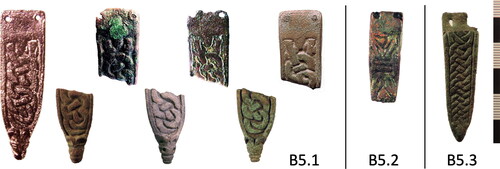
The ring device employed within the interlace of the B5–1 and B5–2 sub-classes is widely seen as having been introduced by the Vikings (Bailey Citation1980, 71–72). All three interlace types are also found in the Class F group. The earliest archaeological dating evidence offered by Thomas for the B5 type is a strap-end from a late ninth-century context in Ipswich (Thomas Citation2000a, 205). We will later consider what their degree of standardisation might reveal about changes in production methods.
Sub-class B5–1
Sub-class B5–1 have terminals with well-formed animal mask features, and are decorated with plump interlace characterised by ‘free rings’ which are interwoven by two strands. This form of interlace appears to have been new to England, being largely absent from the Anglo-Saxon decorative repertoire of the ninth century, posing a question as to its origins. Interlace with ‘free rings’ is known on Viking-Age sculpture in northern England and the Irish Sea region and is occasionally found on other materials, such as the carving on the Ballinderry (Co. Tyrone) wooden gaming board (Hencken et al. Citation1935–1937, 175–90) which displays a range of interlace and Trewhiddle devices, and in Scandinavia it occurs on some dress accessories with Borre-style decoration.Footnote2 All types of B5 interlace, including the ‘free ring’ variety, are also seen on the Class F strap-ends and it may be inferred from this that, upon their arrival in Northumbria with Viking warriors from Ireland, they provided the inspiration for the B5–1 sub-class. The particular form which the ‘free ring’ interlace takes on the B5–1 strap-ends is very distinctive and almost identical on each example.
Only one B5–1 strap-end was known to Thomas, that from Fishergate, York (Rogers Citation1993, 1351), whereas a total of 11 examples are now known from England, all damaged, and these comprise six terminals, four butt-ends, and one which is missing each end.Footnote3 Remarkably, ten are broken diagonally along the same deep transverse groove in the interlace, strongly suggesting a design weakness, leading to a very limited period of usage. The only complete B5–1 strap-end known was found during excavations of the Viking fortress at Aggersborg, in northern Jutland in 1945–54 (Roesdahl et al. Citation2014, 285–286). James Graham-Campbell (Citation1980, 52–53, no. 187) concluded that it must have been made in a northern English milieu under Scandinavian influence, and almost identical examples have subsequently been found at Fishergate in York, Cottam, Stamford Bridge, and other northern sites.
The Aggersborg strap-end was found within the western part of House C, one of the buildings in the pre-fortress village. Søren Sindbaek (pers. comm.) suggests that its discovery ‘on the old ground surface’ (rather than in the accumulated stratigraphy) means that it may be associated with the building. A pit cut by the post holes of House C contained a Borre-style pendant, so the building probably dates to the tenth (or very late ninth) century. Aggersborg now has by far the greatest number of weights and hack silver finds in Jutland, emphasising its special character, perhaps a royal manor, even before the late tenth-century ring fortress was constructed there by Danish king Harald Bluetooth. This context would fit well with a military connection and a returning member of the Great Army, wearing a belt made in Northumbria.
The eight Class B5–1 strap-ends whose condition allows scrutiny, including the Aggersborg example, all bear simple decoration on their reverse, in the form of a groove around the periphery, which underscores the likely influence of the Class F strap-ends with decoration on both sides. This simple decorative device was arguably a further attempt by the Scandinavian colonists to emphasise a new identity, additional to the novel decoration of the main face (Richards and Haldenby Citation2018, 345). This rudimentary reverse decoration is not uncommon on strap-ends of the B5–3 subgroup but is seen only occasionally on examples of other classes of strap-end of Viking date (Classes B4, E3 and E4 which we consider below).
Their significantly increased numbers now allow us to see that this is the most homogenous B5 subgroup, examples even appearing to have come from the same master model. The compact northern distribution of the Class B5–1 strap-ends is also striking, and points clearly to manufacture within Yorkshire.
Sub-class B5–2
Thomas listed just one example of sub-class B5–2, from Coppergate in York (Mainman and Rogers Citation2000, 2569, No.10423) and another has now come to light not far away in Skirpenbeck (E. Yorks.; YORYM-482EE5). Both have stylised animal head terminals and deeply contoured ring-knot interlace of an early type, incorporating lozenges, as seen on mounts and strap-ends from Borre, Norway (Wilson Citation2008, 325–327). This is unlike the ‘vertebral ring-chain’ variety seen on much stone sculpture from Northumbria, and on the longer-lived Class E4 strap-ends discussed below, which Jane Kershaw (Citation2013, 27) believes are a later Anglo-Scandinavian innovation.
Sub-class B5–3
The strap-ends of sub-class B5–3 also have deeply contoured interlace, in this case comprising a four-strand braid, frequently seen in Anglo-Saxon decorative mediums, but only rarely on the main Class A strap-end series. Over 25 examples of sub-class B5–3 are now known, a large increase on those available to Thomas, and again there is a distinct northern bias in their distribution albeit with more diversity in size and decoration than the B5-1 sub-class.Footnote4 A peripheral groove on the reverse is seen on a number of examples, confirming their affinity to the B5–1 sub-class, and suggesting development from it. The second of the Coppergate B5 strap-ends illustrated by Thomas is an anomalous B5–3 variant in lead alloy, possibly a casting pattern or model (Mainman and Rogers Citation2000, 2569, No.10599). It was recovered from Period 5A dump deposits related to the abandonment of the first wattle buildings, now dated to 955-60 (Hall et al. Citation2014, 605). Part of a unique iron strap-end mould was also recovered from Coppergate (Ottaway Citation1992, 523, No.2250). It has a stylised animal head terminal and whilst it was not used in making the Coppergate strap-ends, it demonstrates the casting of strap-ends in Viking York.
Class A1avii: Wooperton type strap-ends
In addition to the arrival of the Army being responsible for the creation of the various sub-types of B5 strap ends, we also propose that it led to the introduction of Class A1avii or ‘Wooperton’ type strap-ends. These were given their more commonly used name from the find spot in Northumbria of one of the first examples described (Bailey Citation1993). In common with most Class A1 strap-ends, and unlike Scandinavian-inspired forms, the Wooperton type has convex sides. The distinctive posture of the Trewhiddle-style animal shows a looped neck and head looking back at a smaller creature developing from its hind quarters (). These and the B5–1 strap-ends exhibit the highest level of homogeneity of size, shape and decoration of all strap-end groups, a distinction which Haldenby (Citation1992) noted with regards to the seven Wooperton examples then known, also observing their Yorkshire distribution. The group were subsequently formally recorded by Bailey (Citation1993, 87–91) who listed nine examples from Yorkshire, arguing they had been produced in a York workshop.
Figure 6. Examples of A1avii ‘Wooperton’ strap-ends (left to right): YORYM-02377C; YORYM-AB5949; YORYM-B1D77B; YORYM-D23B76; YORYM-C82494; NLM-5A69C5.

Thomas (Citation2000a, 76) catalogued 13 examples in total, and a smaller number of another distinctive and standardised Trewhiddle animal type (Class A1aviii), and noted the distinct northern focus of each group which he felt indicated a single point of manufacture. He later described another highly homogenous but more elaborate group, found at Poppleton, near York, again decorated with contorted animals (Thomas Citation2006), and concluded that the remarkable standardisation and creative vitality of each of these groups set them apart from the other earlier Class A1 strap-end subgroups, and placed them right at the end of the series in the late ninth/early tenth century. However, despite finds from Coppergate suggesting continuation of the use of Trewhiddle decoration into the early tenth century (Hall Citation1984, 58), Bailey (Citation1993, 89) felt that the style was nevertheless mainly confined to the ninth century. He also suggested that the uniformity of the Wooperton strap-ends could be explained by some examples having been cast in moulds impressed with the same model (Bailey Citation1993, 90), a deduction with which Thomas (Citation2000a, 149) subsequently agreed.
A Wooperton type strap-end has since been found on the site of the tenth-century settlement at Cowlam, East Yorkshire (Richards et al. Citation2013, 245). This settlement succeeded the adjacent Anglo-Scandinavian settlement at Cottam B where most such finds were recovered (including a further Wooperton strap-end) and in view of Thomas’s late dating, this may have been one of the first losses on the Cowlam site.
We have now located 44 examples, mainly from Yorkshire, with a handful from Lincolnshire and just one from East Anglia ().Footnote5 The degree of this northern bias can be gauged by comparison with the widespread distribution of the Trewhiddle group as a whole (), and the extremely close similarity in form and decoration observed by Thomas persists. Hence, for these strap-ends, since we are now aware of significant numbers and given their highly homogenous form, we feel justified in confirming that, like Class B5–1, they were cast, as Bailey and Thomas tentatively suggested.
Plate-headed pins
Finally, we suggest that another artefact type, plate-headed pins, was in contemporary usage with the preceding types of strap-end during the transition to Scandinavian settlement. Plate-headed pins are a subgroup of ‘collared’ pins, terms used by Haldenby to describe the two-dimensional form of the head and the feature directly beneath this, which is present on most pins of the period. He has now identified 129 examples, a considerable number, although representing only 4% of all ‘collared’ pins (Haldenby Citation2012, 7).Footnote6 They comprise five basic forms: discoidal; lozenge, sometimes with truncated apex; small pentagonal; rectangular, and large discoidal (). The small discoidal variety represent around 60% of the group and each has around six ring-and dots, a motif present on all plate-headed pins, apparently applied with a bow drill and bit.
Figure 8. The five main types of plate-headed pins: (1) discoidal (DUR-9B661C); (2) lozenge (FAKL-AE35B4); (3) small pentagonal (LANCUM-B47C34); (4) rectangular (LIN-9033A8); (5) large discoidal (YORYM-546D89).

Ross (Citation1991, 37) described them in his doctoral thesis on pins, and from the few examples then known noted a Yorkshire distribution. We can now confirm a clear northern focus for the bulk of the group (). The suggested dating of published examples ranges from the eighth to the tenth century, but we have suggested that ‘plate-headed’ pins were a ‘showy’ form of ‘collared’ pin introduced in the late ninth century (Haldenby and Richards Citation2009, 314), and subsequently we proposed, more precisely, that they emerged during the transition to Scandinavian settlement, i.e. a decade or a little more beyond 866 (Haldenby and Richards Citation2016, section 4.3). Evidence for this came from the site of Cottam B where more plate-headed pins have been found than anywhere else, including York which has produced twelve. At Cottam B a wide range of dress accessories, including pins, is found in two areas of Anglo-Saxon activity, one of which became an Anglo-Scandinavian farmstead, and it is this area where fifteen plate-headed pins were found. Only five were found in the other Anglo-Saxon area, leading us to propose that the presence of the majority of these pins, and others which we deemed contemporaneous, in one area suggests this saw a brief extension of Anglo-Saxon activity following the overthrow of York, before being resettled as an Anglo-Scandinavian farmstead.
The explanation for the narrow spatial distribution and dating of these pins should, we suggest, be seen in the same light as that proposed for the Class B5 and A1avii strap-ends: in short, plate headed pins belong to a suite of distinctive dress accessory produced in large numbers in workshops under new Viking control, following the capture and occupation of York. We also suggest that, in common with the strap-ends, these pins were cast, their two-dimensional shape facilitating speedy pouring into simple one-piece moulds, and finishing by filing and decorative drilling.
Longer-lived dress accessories
Three classes of strap-end with Scandinavian affiliations — B4a, E3 and E4 () — recur on Northumbrian sites with other Viking finds (Haldenby and Richards 2018, 339–340). Thomas (Citation2000a, 154) felt the heavy relief decoration seen on each type was achieved by casting. Each type is found in the Irish Sea region, with examples spread across eastern England, from Suffolk to North Yorkshire: they are not confined to Northumbria, providing a contrast with the types described above (). As with the broad distribution of pre-Viking dress accessories, the distribution of these longer-lived strap-ends may have resulted from unfettered interaction and trade, over a prolonged period of time. Such widespread distributions are the norm in the ninth and tenth centuries, while artefacts with a confined northern bias result from short-lived circumstances in the late 860s and early 870s, largely prior to extensive Scandinavian settlement.
Figure 10. Examples of B4a (Cottam ‘B’, YORYM-174D97); E3 (LVPL-537933, YORYM-D98B74); and E4 strap-ends (LANCUM-BAC646, NMS-393CA2).
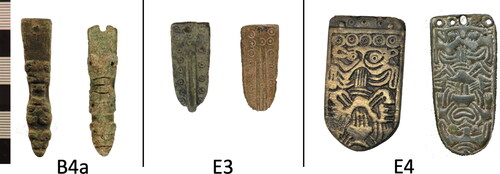
A further interesting contrast is observed when the level of activity in the vicinity of the find spots of these strap-ends is compared to that seen close to finds associated with the Great Army, such as the sword pommels. If the latter losses did indeed result from this military force moving across the landscape, then sword pommels ought more often to be isolated finds, compared to the assemblages one might expect in areas where activity was longer term perhaps on or close to settlements. From the PAS database we have indeed been able to discern this difference, with the pommels being twice as likely as the B4a, E3 and E4 strap-ends to be found with no contemporary material nearby.
Although the widespread distribution of the B4a, E3 and E4 strap-ends suggest these are longer-lived types, Thomas (Citation2000a) suggests their arrival dates to the mid- to late ninth century. Again, some examples come from western England, and Ireland; but there are too few to demonstrate that they were lost during the movements of the Great Army although their presence in the winter camps of Aldwark and Torksey suggests a connexion.
B4a strap-ends
The narrow parallel-sided Class B4a strap-ends are decorated with two confronted animal masks, and a third at the terminal, each with a Borre-style head similar to those seen on the Viking Great Army period strap distributors and related military finds discussed above. However, their distribution differs, being more confined to Yorkshire, Lincolnshire and East Anglia. Thomas identified 16 examples, greatly exceeded by the 62 now known.Footnote7 He noted similarly decorated metalwork from Scandinavia including three almost identical hasps attached to the hub of a strap distributor from Västergötland, Sweden, but was undecided about which side of the North Sea the particular style originated (ibid., 245). An example has now been found at Aldwark (Williams Citation2020, 53), which is unlikely to be much later than 876, and Thomas also referred to examples from the mid-ninth century. Several examples come from both Stamford Bridge 2 and Cottam ‘B’, each of which saw Viking activity from the ninth and into the tenth century. Thomas (Citation2000a, 259) felt their presence in northern Scotland and the Irish Sea region suggested they may have been introduced by Vikings from Ireland, and then taken up by Scandinavian communities within England. Their deeply contoured design was clearly not hand carved and there is some supporting evidence, in the form of what may be lead models, that they were cast (Thomas Citation2000a, 526).
Class E3 strap-ends
The Class E3 strap-ends have the broad, tongue-shaped form which became common in the tenth century, and are decorated with one or more median ribs, often with ring-and-dot motifs on either side. Eighteen were known to Thomas (Citation2000a, 251) but we have now mapped 91 from England.Footnote8 The discovery of several examples in Scandinavia and on the continent led Thomas to conclude a Carolingian origin, but again he suggested that they probably entered the country from the west since they are common in the Irish sea region. At that stage the largest group was an assemblage of four from Carlisle Cathedral and, although they are mainly spread across eastern England there are also examples from north-west England and the Welsh Marches, and one was found accompanying Burial LXXXV at Golden Lane in Dublin (Griffiths Citation2010, 151–152). Thomas (Citation2000a, 213) dated them fairly widely to the late ninth into tenth century, and whilst the Dublin example has been placed a little earlier, in the mid-ninth century (Griffiths Citation2010, 152), the radiocarbon date for the burial of AD 678–832 has not been adjusted for any Marine Reservoir effect so the burial is probably later than the date suggests (Griffiths Citation2010, 76).
Thomas suggested that the E3 types from eastern England were derivative, tenth-century examples, based on Irish Sea models. However, this largely rested on the presence of ring-and-dot decoration, which he saw as a later style, and therefore linked that on the Class E3 strap-ends from eastern England with the taking of York by Hiberno-Norse in 919. However, there are now 14 Class E3 strap-ends recorded at Aldwark, where mis-shaped examples, flashing, and finishing marks show that they were cast on the Viking camp in the late 870s, and on which ring-and-dot ornament is largely absent (Williams Citation2020, 53, 82–83). A lead alloy Class E3 strap-end from Aldwark may also be a pattern or model for casting identical strap-ends in copper alloy (ibid., 53). In contrast, there are only four examples from the earlier Viking camp at Torksey, one of which is an unusual type made of iron. In summary, it now seems likely that the Class E3s were a Carolingian-style strap-end introduced by the Great Army, and manufactured at Aldwark as an initiative by craft workers with an eye to producing goods for settlers. The form became so successful that the basic design was to remain current for years, being taken up throughout eastern England as well as spreading westwards to the Irish Sea region.
Class E4 strap-ends
The Class E4 strap-ends are also broad and tongue-shaped, with deeply contoured Borre-style decoration which Thomas dated from the second half of the ninth century to the second half of the tenth century. They were divided by him into three main decorative types: animal masks with ring-knot; vertebral ring chain, and other related interlace forms. Thomas’s list of twelve examples had a marked East Anglian bias but we now know of 58, each sub-group distributed fairly evenly across eastern England.Footnote9 Once again, Thomas (Citation2000a, 252) noted their presence in the Irish Sea region, including an example from Dublin, and we can add examples from Shropshire, Leicestershire, and southern England. A possible late ninth-century example has been found at Aldwark; whilst tentatively described in the site report as one arm of a trefoil brooch (Williams Citation2020, 56) it lacks any sign of the broadening which would support this interpretation.
Discussion
The evidence from this detailed analysis of the distribution and forms of Scandinavian-influenced dress accessories indicates important changes in metalwork production in Northumbria after the arrival of the Viking Great Army in 866. These changes hold the key to the creative vitality and innovation of the Class A1avii and B5 strap-ends along with the striking homogeneity and northern distribution of each group. We suggest this in part involved inevitable power shifts within York following its capture, including the creation of Scandinavian-controlled workshops where such dress accessories were created. Whilst the main Viking army campaigned south of the Humber for the next decade and more, these workshops would have continued supplying the resident Anglo-Saxon population within York and its hinterland with manufactured goods, including new innovations such as the three new strap-ends and pin types which we have shown share the same compact northern distribution. This trade may well have remained largely regional due to Viking activity to the south disrupting wider networks.
As well as continuing to cater for Anglo-Saxon tastes the new craft-workers drew on the artistic repertoire of the Scandinavian homelands and new colonies, such as Ireland, to decorate the Class B5 strap-ends in a fashion that might also appeal to the growing immigrant population. Their parallel-sided form was also imported although their rudimentary reverse decoration provided a new twist. The Scandinavian associations of the B5 strap-ends is supported by the recovery of five examples from a site close to York, Stamford Bridge 2, which has produced a range of exclusively Viking finds (Richards and Haldenby Citation2018, 335, 345). Additionally, the two examples from the site of Cottam ‘B’ come from the area of Viking activity. Like the A1avii Wooperton type strap-ends, but alone amongst groups with Scandinavian-inspired design, the B5 strap-ends did not generally stray far south of their place of manufacture in Aldwark or York, probably partly due to the same truncated trading networks, but the evident design weakness shown by the consistent lateral breakage of the Class B5–1 strap-ends must have limited demand. Nonetheless, their production may have continued for a little longer than the A1avii strap-ends, leading to their appearance on Scandinavian settlements in Northumbria and the slightly greater penetration towards the south of some of the derivative members of the group (Class B5–3).
Central to our explanation as to why the Class A1avii and B5 strap-ends are so homogenous and numerous is the casting process by which they were made, in common with much Scandinavian-influenced fine and deeply contoured metalwork including the longer-lived strap-end groups B4, E3 and E4. This was not the case in Anglo-Saxon England where strap-ends were just as often fashioned by hand (Thomas Citation2000a, 148–154). Designs were delineated by grooves which were cut by chasing or the repeated hammering of a chisel, creating regular breaks as clearly indicated on a Class Class A1aiv strap-end from Cottam B ().
Figure 12. Hand wrought strap-end from Cottam ‘B’ (YORYM-9D8DA2), showing multiple tapping of the chisel, evident in the broken lines delineating the animal, increasing the likelihood that the inlay would key firmly into the design.
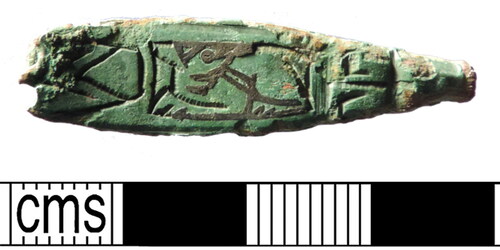
Evidence of casting is plentiful across the Viking world in the form of mould fragments, casting waste and lead models. Further evidence comes in the form of ‘motif pieces’, usually in bone and cut with zoomorphic and interlace designs which were intended for transfer to finished, cast decorative metalwork. Some uncertainty remains as to the part that these pieces played in this transfer. Uaininn O’Meadhra (Citation2015, 373–402) has studied the hundreds of examples from Ireland where they are chiefly found, including a large number from Dublin, and she points out that motif pieces had been in use in association with metalwork production since long before the Viking period, during which time they are unknown in Anglo-Saxon or continental contexts. In Ireland motif pieces played a significant role in the serial production of much elaborate metalwork from the fifth century onwards. O’Meadhra (Citation2015, 375) concluded that they most likely represent ‘apprentices’ learning attempts and artisan’s trials, worksheets and samplers’ and that their presence at places like York and London, albeit in much smaller numbers, suggests Irish contact. She considered most motif pieces to be ‘cast-offs’ and not ‘the good finished examples’ (ibid., 375). A pre-Viking example of an oft-noted close relationship between motif pieces and finished objects is the similarity in quality and design of a motif piece from Co. Meath and a particular shrine mount (Youngs Citation1989, 178).
That the Vikings in Ireland enthusiastically adopted the use of motif pieces is demonstrated by the very large numbers found in Dublin with Scandinavian interlace and animal designs. These often take the form of deeply contoured decorative interlace panels similar to those seen on the double-sided Class F strap-ends, again strongly implying a close link with finished metalwork. We contend that these double-sided strap-ends arrived in York with the Vikings and accompanying artisans who adapted them to produce the B5 group, using their knowledge of motif pieces and the casting process in general. An accomplished motif piece from Coppergate () has a panel of four-strand interlace braid, and proficient Trewhiddle style animals in various postures, decorative schemes which were clearly contemporaneous and which are closely related to those on the Class A1avii and B5 strap-ends. We have already noted the absence of prototype B5–1 ‘free-ring’ interlace design on contemporary metalwork which might have been copied, other than on the Class F strap-ends, so it is particularly significant that close parallels for this distinctive form of interlace are observed on Irish motif pieces such as one from Dublin (McGraw Citation2015, 407). This example is probably not sufficiently accomplished to have served as other than a student trial piece. Nevertheless, the creators of the decoration on the Coppergate motif piece and another highly accomplished piece from York (Tweddle, Moulden, and Logan Citation1999, 277) were clearly capable of creating a level of decorative complexity sufficient for the direct taking of impressions to facilitate casting, although such a direct function remains to be fully demonstrated. What is also evident is that the high numbers of Class A1avii and B5–1 strap-ends, with such novel and almost identical design, could only have been produced by casting from moulds produced from the same model, whether or not motif pieces served this particular function. That the same model was employed is further indicated by the fact that as well as the transfer of highly-standardised decoration, design flaws were also passed on as evidenced by the regular pattern of breakage seen on the B5–1 strap-ends. Helpfully in terms of dating evidence, these high levels of uniformity are indicative of short-lived circulation. The lead alloy strap-end models from Aldwark and Coppergate, as well as the iron strap-end mould recovered from Coppergate, all confirm manufacture in the York area. As noted by Richard Hall (Citation2000, 320): ‘Whatever the underlying propagandist or commercial processes which initiated new, mass production in workshops in York, their output had the potential to be hugely influential, dispersing relatively cheap copies of aristocratic fashion to an unprecedented extent’.
In conclusion, this paper has demonstrated that as more material is added to the database of the Portable Antiquities Scheme it is now possible to use the dating evidence provided by the historically documented incursions and camps of the Viking Great Army, and by excavated and systematically metal detected sites such as Cottam, to refine the dating and origins of several categories of Anglo-Scandinavian metalwork. In turn this illuminates a key moment in English history and demonstrates the creation of regional identities in confined periods. This is particularly evident in Yorkshire as the local workshops came under Viking influence and control, and where we can see evidence for Irish Viking influence on decorative styles and methods of production.
Acknowledgements
The authors would like to thank Søren Sindbaek of the University of Aarhus for providing additional information from his post-excavation analysis of the Danish site at Aggersborg; Ruth Johnson, Dublin City Archaeologist, for information on Irish motif pieces; Gabor Thomas, University of Reading, for assistance with images for B5 strap-ends; Mark Randerson for contributions on the Aldwark E3 and E4 strap-ends, and the following for information regarding specific finds: Mark Bagley, Steve Foster, Chris Hannard, Dave Hirst and Christian Whitehead. Michael Lewis and colleagues gave permission to use images from the Portable Antiquities Scheme. All distribution maps were kindly produced by Helen Goodchild of the University of York Department of Archaeology using Copernicus data and information funded by the European Union comprising EU-DEM layers.
Disclosure statement
No potential conflict of interest was reported by the authors.
Additional information
Notes on contributors
Dave Haldenby
Dave Haldenby is an independent researcher, and volunteer at Hull and East Riding Museum. His main area of interest is the Early Medieval period about which he has written both independently and with others, including Julian Richards with whom he has collaborated for over 30 years.
Dawn M. Hadley
Dawn M. Hadley is Professor of Medieval Archaeology at the University of York. She has published widely on the society and cultures of Early Medieval England and the Viking Age. She has focussed, in particular, on issues of ethnicity, migration, gender, childhood, and funerary practices. She is currently collaborating with Julian Richards to investigate the Viking Great Army of the late 9th century and their winter camp at Torksey (Lincs), with an extended project, Tents to Towns, on the broader impact of the Viking Great Army.
Julian D. Richards
Julian D. Richards is Professor of Archaeology at the University of York and Director of the Archaeology Data Service. He has directed excavations of Early Medieval settlements at Cottam, Cowlam, Burdale, and Wharram Percy (Yorks). He has also excavated the only Viking cremation cemetery in the British Isles at Heath Wood, Ingleby (Derbys). He undertook one of the first research projects to make use of metal-detected evidence to investigate the Viking and Anglo-Saxon Landscape and Economy of England.
Notes
1 Buckles: Aldwark (N. Yorks), Meols (Wirral), Eynsham Abbey (Oxon), plus WILT-C617D7; KENT-61392E, -A569D6; YORYM-55A828; Strap-ends: Aldwark, Meols, Gt Mongeham (Kent), Flixborough (N. Lincs), plus YORYM-077738, -F3A944, -ED121C; SWYOR-B557B2; OXON-23E4AA; WREX-E4B61E; LANCUM-8AE737; NARC1710, -3835F4; NMS-627136, -2CE528; LANCUM-2AD712; NLM-FF6543, -A30415; SUSS-742D82; NMGW-9E75E1; CPAT-28F196; DOR-D966F2.
2 e.g. DIME find number 57260, https://www.metaldetektorfund.dk/fund/?dimeid=57260
3 Fishergate, South Ferriby, plus YORYM-0219E8, -635EE3, -DEFC92, -4F55E0, -04F067, -4855E8; LIN-DDEA45; DENO-AE67F4; NCL-1905000.
4 Sleaford (Lincs), Ipswich (Suffolk), Coppergate (York), North Cave (E. Yorks), Letchworth (Herts), Seaton (E. Yorks), Aldwark (N. Yorks), Winteringham (N. Lincs), plus DENO-475FD2, -839B93; LANCUM-9331CA, -AEED77; NLM-22F9E3, -ADFA0B, -BACCC3; NMS-246FD4; PUBLIC-11A2FD; SWYOR-1F8A19, -2633C4, -8D4385; YORYM-0210C2, -14F920, -30314A, -4FD9F3, -9D4B80, -B001D5.
5 Wooperton (Northumberland), Hale (Cheshire), Ashby (Cumbria), Ruskington (Lincs), Thorpe Salvin and Skelbrooke (S. Yorks), Yapham, Cottam ‘B’, Cowlam and South Newbald x 2 (E. Yorks), Hungate (York), and 1 York unprovenanced, Goldsborough, Ryther x 2, Sherburn in Elmet x 2, Snainton, Whitby, and unprovenanced x 2 (N Yorks), plus FAKL-176E22; LANCUM-B9D2A3; LIN-957013, -FC5447; NCL-46D683; NLM-5A69C5, -88B762; NMS-B8801E; SWYOR-29A341, -2F3D13, -9A0EFC, -F32A50; YORYM-02377C, -4E2196, -72A2EB, -AB5949, -B1D77B, -B329C0, -C82494, -D23B76, -E2E718, -F31955.
6 Cottam ‘B’ x 12, Millington x 7, South Newbald x 7, South Ferriby x 2, Welton, York x 12, Hartlepool, Whitby x 3, Flixborough x 15, Hamwic x 2, plus CORN-73C927; DENO-7B4BB0; DUR-9B661C; FAKL-007320, -008CF2, -00A524, -2942C4, -2B21B6, -5C00F6, -AE35B4, -AE8940, -C13BF3; GLO-A6EA11; HAMP-80C837; HESH-1BEDA8; LANCUM-2D98D3, -B47C34; LIN-0187A0, -9033A8, -99737D, -B01482; LVPL-60DEB3, -A6C291; LVPL1086; NCL-232407, -AA3293, -D44ED2, -DACBF7; NLM-140058, -7A2D15, -E58663, NLM4235; NMS-EB3A90; NMS33; SF-90FD37, -911175; SWYOR-04A376, -2635D2, -7D9174, -B3B544, -F00A61; WILT-B25DEA, YORYM1161, M225, M91; YORYM-07E9E4, -0EB048, -12347B, -2D0329, -2D20B6, -2F1748, -33E477, -4EF867, -53A1C7, -5435D7, -546D89, -664B55, -66698A, -6A6EE6, -70EA26, -83293A, -8E4803, -C242FC, -C43605, -C45EC1, -EA7116, -EAA3B3.
7 Fishergate and St Mary’s Abbey (York), Aldwark (N. Yorks), Beverley, South Newbald, Cottam ‘B’ x 3, Cowlam (E. Yorks), Aylesby, Ewerby, Horkstow, Laughton (Lincs) and ‘unprovenanced' (N. Lincs), Ketteringham (Norfolk), Otley (Suffolk), Hurly Hawking (Angus), plus BH-00B335; DENO-CB4B63, -E40172; DOR-DF7201; DUR-05C5B6; HAMP1777; LEIC-9E82B3; LIN-2C0663, -68D957, -A36A21,-CD8371, LIN-E848A7; LVPL-3D6EE1; NLM-2CFD94; NLM2820, -4544, -4596; NMS-0E78A4, -5D08E8, -642C03, -94EB57, -C237E6, -C3E0E9, F9A0F7; NMS84; PUBLIC-F03E4B; SF-3EEF26, -A129F6, -DB96F8; SUR-D14C32; SUSS-CF0266; SWYOR-1614B6, -42AB34, -5141D8; WM1D-3A6998; YORYM-06004B, -174D97, -38EEB2, -4846D6, -484DA8, -4872F1, -4877E3, -AF4626, -E6A40A, -FBD5C4.
8 Aldwark x14, Ryther x 2, Norton (N. Yorks), Cowlam x 3, Cottam ‘B’, Pocklington (E. Yorks), Torksey, Louth x 3 (Lincs), Peel (IoM), Carlisle, Carlisle Cathedral x 3 (Cumbria), Royston (Herts), Bawsey, Oxborough, Stow Bedon (Norfolk), Nacton (Suffolk), plus BERK-67BD51; CAM-0BE06D, -7F732C; ESS-6EAC49; FAKL-EB0BB3; GLO-C1A050, -F54184; LANCUM-2DA5B8; LIN-2740A6; LVPL-0FBC7D, -537933, -9EAF83, -E3B043; NCL-A802A7, -F54642; NLM-1F77A8, -362BE4, -76B7C9, -B633CE, -CD496E; NLM1060; NMS-064544, -4DF139, -710070, -7A4296, -C387A8, -C65947, -C7235F, -D3AFE2, -EB9CB8, -8B9C16; SF-1A7516, -46A5E4, -935106, -DAE06C; SF1596, -7486, -7596; SWYOR-324306, -B3485C, -D0AC0D; WMID-162203; YORYM-3298D1, -45B93D, -610656, -61A695, -6E50A8, -711C49, -99D605, -9BA918, -D98B74, -F33FC7, -F353E7, -F52073, -FB0BD7, -FE4BB2.
9 Bawsey, Blo Norton, Great Walsingham, Hillington, North Creake, Taverham (Norfolk), Thelnetham (Suffolk), Buntingford, Weston (Herts), Hatcliffe (Lincs), Elloughton (East Yorks), St Mary Bishophill (York), Workington (Cumbria), plus BH-985BB2; ESS-BE9A25; FAKL-8B6E69, -E19532; HAMP-2D60A0; HESH-B84126; LANCUM-BAC646, -D9D731, -F3ABD5; LEIC-AE3855; LIN-9A2879, NLM-466BD0, -66E451, -75, -F4E3D9, NLM161, 2763, 399, 400; NMS-331DE4, -393CA2, -5B1D66, -630833, -6ACE19, -96C741, -AB4EDE, -B63E39, -DB62E1; SF-393112, -80AF08, -8E0554, -A6C567, -BF2015, -D21631, SF9073; SOM-9ABAE0; SUR-F5F2E4; SWYOR-087A70, -396A20, -5F2513; YORYM-485AA7, -669BF4, -91CCC4, -F372F2, -F46EFA.
References
- Aksdal, J. 2017. “Dei Anglosaksiske Sverda. L-Typesverd i England og Skandinavia.” Viking 80: 59–88. http://doi.org/10.5617/viking.5474.
- Bailey, R. N. 1980. Viking Age Sculpture in Northern England. London: William Collins.
- Bailey, R. N. 1993. “An Anglo-Saxon Strap-End from Wooperton.” Archaeologia Aeliana Series 5 (21): 87–91.
- Bersu, G., and D. M. Wilson. 1966. Three Viking Graves in the Isle if Man. Society for Medieval Archaeology Monograph Series 1. London: Society for Medieval Archaeology.
- Graham-Campbell, J. 1980. Viking Artefacts: A Select Catalogue. London: British Museum Publications.
- Griffiths, D. 2010. Vikings of the Irish Sea – Conflict and Assimilation 790–1050. Gloucester: The History Press.
- Hadley, D. M., and J. D. Richards. 2016. “The Winter Camp of the Viking Great Army, AD 872-3, Torksey, Lincolnshire.” The Antiquaries Journal 96: 23–67.
- Hadley, D. M., and J. D. Richards. 2018. “In Search of the Viking Great Army: Beyond the Winter Camps.” Medieval Settlement Research 33: 1–17.
- Hadley, D. M., and J. D. Richards. 2021. The Viking Great Army and the Making of England. London: Thames and Hudson.
- Haldenby, D. 1992. “Anglo-Saxon Strap-Ends – Readers’ Finds Part 3.” Treasure Hunting, June 1992, 27.
- Haldenby, D. 2012. Early Medieval ‘Collared’ Pins. Datasheet 44, The Finds Research Group AD 700–1700.
- Haldenby, D., and J. D. Richards. 2009. “Settlement Shift at Cottam, East Riding of Yorkshire, and the Chronology of Anglo-Saxon Copper Alloy Pins.” Medieval Archaeology 53: 309–314.
- Haldenby, D., and J. D. Richards. 2016. “The Viking Great Army and Its Legacy: Plotting Settlement Shift Using Metal-Detected Finds.” Internet Archaeology 42. https://doi.org/10.11141/ia.42.3
- Hall, R. A. 1984. The Viking Dig. London: Bodley Head.
- Hall, R. A. 2000. “Anglo-Scandinavian Attitudes: Archaeological Ambiguities in Late Ninth- to Mid-Eleventh-Century York.” In Cultures in Contact: Scandinavian Settlement in England in the 9th and 10th Centuries. Studies in the Early Middle Ages 2, edited by D. M. Hadley and J. D. Richards, 311–324. Turnhout: Brepols.
- Hall, R. A., D. T. Evans, K. Hunter-Mann, and A. J. Mainman. 2014. Anglo-Scandinavian Occupation at 16-22 Coppergate: Defining a Townscape. Archaeology of York 8/5. York: Council for British Archaeology.
- Hencken, H. O., G. Harrington, H. L. Movius, A. W. Stelfox, and G. Roche. 1935–1937. “Ballinderry Crannog No.1.” Proceedings of the Royal Irish Academy 43: 103–239.
- Kershaw, J. 2013. Viking Identities: Scandinavian Jewellery in England. Oxford: Oxford University Press.
- Leahy, K. 2014. “A Bit of Blarney?” The Searcher. Feb. 2014: 36–38.
- Mainman, A. J., and N. S. H. Rogers. 2000. Craft, Industry and Everyday Life. Finds from Anglo-Scandinavian York. Archaeology of York 17/14. York: Council for British Archaeology.
- Martens, I. 2004. “Indigenous and Imported Viking Age Weapons in Norway – a Problem with European Implications.” Journal of Nordic Archaeological Science 14: 125–137.
- O’Meadhra, U. 2015. “Copies or Creations? Some Shared Elements in Hiberno-Norse and Scandinavian Artwork.” In The Vikings in Ireland and Beyond, edited by H. B. Clarke and R. Johnson, 373–402. Dublin: Four Courts Press.
- McGraw, J. L. 2015. “Practice Makes Perfect? Motif-Pieces as Tools of Communication and the Exchange of Tacit Artistic Knowledge in Viking-Age Dublin.” In The Vikings in Ireland and Beyond, edited by H. B. Clarke and R. Johnson, 403–415. Dublin: Four Courts Press.
- Ottaway, P. 1992. Anglo-Scandinavian Ironwork from Coppergate. Archaeology of York 17/6. London: Council for British Archaeology.
- Richards, J. D., P. Beswick, J. Bond, M. Jecock, J. McKinley, S. Rowland, and F. Worley. 2004. “Excavations at the Viking Barrow Cemetery at Heath Wood, Ingleby, Derbyshire.” The Antiquaries Journal 84: 23–116.
- Richards, J. D., S. Ashby, T. Austin, D. Haldenby, M. Hummler, E. Jelley, J. Richardson, S. Roskams, and K. Niven. 2013. “Cottam, Cowlam and Environs: An Anglo-Saxon Estate on the Yorkshire Wolds.” Archaeological Journal 170 (1): 201–271.
- Richards, J. D., and D. Haldenby. 2018. “The Scale and Impact of Viking Settlement in Northumbria.” Medieval Archaeology 62 (2): 322–350.
- Richardson, C. 1993. “The Borre Style in the British Isles: A Re-Assessment.” MLitt. thesis., University of Newcastle.
- Roesdahl, E., S. M. Sindbaek, A. Pedersen and D. M. Wilson, eds. 2014. Aggersborg: The Viking-Age Settlement and Fortress. Jutland Archaeological Society Publications 82. Højbjerg: Jutland Archaeological Society in Association with The National Museum of Denmark.
- Rogers, N. S. H. 1993. Anglian and Other Finds from 46-54 Fishergate: The Small Finds. Archaeology of York 17/14. York: Council for British Archaeology.
- Ross, S. 1991. “Dress Pins from Anglo-Saxon England: their Production and Typochronological Development.” DPhil. thesis., University of Oxford.
- Thomas, G. 2000a. “A Survey of Late Anglo-Saxon and Viking-Age Strap-Ends from Britain.” PhD thesis, Institute of Archaeology, University College London.
- Thomas, G. 2000b. “Anglo-Scandinavian Metalwork from the Danelaw.” In Cultures in Contact: Scandinavian Settlement in England in the 9th and 10th Centuries. Studies in the Early Middle Ages 2, edited by D. M. Hadley and J. D. Richards, 237–255. Turnhout: Brepols.
- Thomas, G. 2006. “Reflections on a ‘9th-Century’ Northumbrian Metalworking Tradition: A Silver Hoard from Poppleton, North Yorkshire.” Medieval Archaeology 50 (1): 143–164.
- Townend, M. 2014. Viking Age Yorkshire. Pickering: Blackthorn Press.
- Tweddle, D., J. Moulden, and E. Logan. 1999. Anglian York: A Survey of the Evidence. The Archaeology of York 7/2. York: Council for British Archaeology.
- Vlasaty, T. 2018. “Bronze Anglo-Saxon Sword Pommels.” In Projekt Forlǫg: Reenactment a věda. Accessed 12 November 2020. https://sagy.vikingove.cz/bronze-anglo-saxon-sword-pommels/
- Whitelock, D., ed. 1961. The Anglo-Saxon Chronicle. London: Eyre and Spottiswoode.
- Williams, G., ed. 2020. A Riverine Site near York: A Possible Viking Camp? British Museum Research Publications 224. London: British Museum Press.
- Wilson, D. M. 2008. “The Development of Viking Art.” In The Viking World, edited by S. Brick and N. Price, 323–338. London: Routledge.
- Youngs, S. 1989. The Work of Angels: Masterpieces of Celtic Metalwork 6th–9th Centuries AD. London: British Museum Publications.

